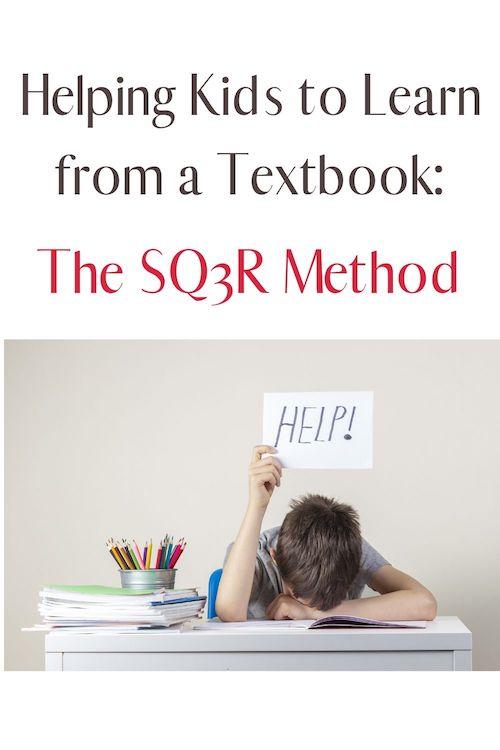The SQ3R Method is an excellent way to help kids learn from a textbook. This post will show you what the SQ3R Method is and how to teach it to your kids.

As a long-time, homeschooling parent of 7 kids with dyslexia, I don’t usually recommend a traditional textbook approach to learning for students with dyslexia. For many reasons, this type of learning just doesn’t work well with their creative, outside-the-box learning style. Many dyslexic kids lack the organizational and active learning skills necessary to learn well from a textbook. They tend to do better with hands-on, discussion-based learning.
However, there is a time and a place to use a textbook. Since it is likely that even our homeschooled kids will have to learn from a textbook at some time in their lives, learning to learn from a textbook is kind of a life skill.
Kids with dyslexia tend to be more passive learners. The SQ3R Method encourages active learning.
Learning from a Textbook: The SQ3R Method
SQ3R is an acronym for Survey, Question, Read, Recite, Review and is an excellent way to get kids actively looking for information before and during the reading of a passage.
SQ3R Step 1: Survey
Before reading, have your child take a few minutes to skim through (or survey) the passage, focusing attention on the titles, headings, and subheadings of the assigned passage. Take a quick look at the entire assigned reading. Skim the title, headings, and subheadings. If your reading includes them, look through the summaries and review questions at the end of each section. Note graphics, italics, boldface type and other devices the author uses to highlight important information. Based on this quick survey, make predictions about what you think the author is going to say. Write these predictions down.
The purpose of this survey is to give your child a good idea of what the passage is going to be about.
SQ3R Step 2: Question
Based on the information gained from the previous survey step, have your child ask some questions. Change each heading and subheading into a question or series of questions that the author will answer in the section. The better your questions, the better you’ll understand the material when you read it thoroughly. Write these questions out. You’ll use these questions as an outline to organize the notes you’ll take while reading the material closely.
The purpose of this step is to stimulate curiosity and engagement in the passage. Other good questions to ask (especially for younger kids) are: What is this passage going to be about? What do I already know about this subject? What do I want to know about this subject?
SQ3R Step 3: Read
Now it’s time to read the passage. Underline or highlight information that relates to the questions you asked in the previous step. Read one section at a time, making brief notes that answer the questions you’ve written down in step 2. Your notes should be short–don’t worry about grammar, spelling or punctuation. You may need to develop additional questions to organize your information.
SQ3R Step 4: Recite (or Recall)
After each section, stop and try to recall the information from memory. Look at the questions you identified in step 2. Without looking at your notes, state out loud (this is important) the answers to those questions. If you can’t recall the answers from memory, reread the section, refine your notes and repeat this step. Don’t move onto the next section of your reading until you can recite the new information from memory.
SQ3R Step 5: Review
When you’re finished reading, making notes, and reciting/recalling each section, look back over your entire reading assignment. Review the questions for each section and without looking at your notes, recite (out loud) the answers. If you can’t remember all the answers, reread that section, review your notes and repeat this step. Return to the predictions you made in the first (Survey) step. How many are accurate?
Teaching Kids to Use SQ3R
I do, we do, you do
This is a method of teaching that is super helpful for many things from cleaning a bedroom to using the SQ3R method.
I do. In this stage of teaching, you are modeling exactly how to complete each step. Explain what you are doing and why, allowing them to ask questions if they have any.
We do. In this stage of teaching, you are working on the SQ3R method together. Allow your student to attempt to use the method, while you prompt and direct as necessary. Do this until they seem to have a good understanding of the method.
You do. In this stage, your child can apply the method on their own without your supervision. There is no set amount of time for each of these stages. When you see that your child is ready to move on, do it!
That’s it. Remember to use what works from this method and adapt it to meet the unique needs of your children.
Download a copy of the SQ3R Method
To download a printout of this method, click here.
More teaching tips?
I hope this strategy is helpful to you! For more Teaching Tips, click here.





thankyou this was very helpful.
I am a 74 year old dyslexic. Was taught this technique in the very early ’60s in junior high school. Works extremely well. Managed to get my reading speed up from about 400 wpm to 1200 wpm in high school and was later tested at an amazing 3000 wpm at work where I evaluated complex bids for telephone systems and related systems.
Reading at high speed does not allow the words to jump around on the page for me like it does when reading at a snail’s pace.
Keep up the good work!!